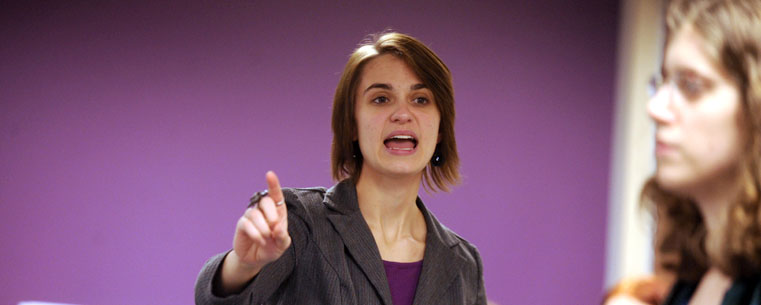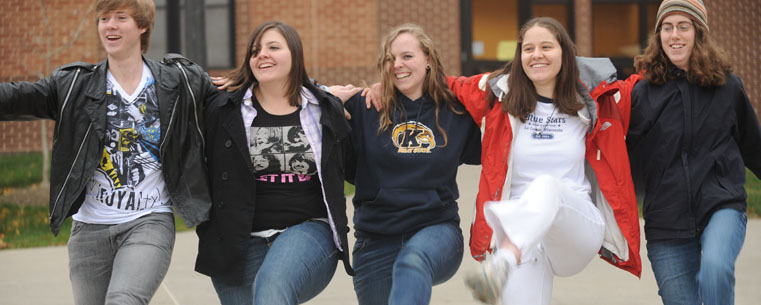Recent Success Stories
- New Kent State President Embarks on Listening Tour
- Scholar Helps Fight Crime With Violence Prevention Research
- Welcome, President Warren
- Destination
Kent
State
Returns - Now Serving More Than 300 Student Organizations
- Visit Kent State
- Kent State Captures Eighth Jacoby Trophy
- Scholar Supplies Global Technology Knowledge to Students






Collaborative Learning Takes to the Stage
Centuries before the Shakespearean era, drama was an important part of English popular culture. The most lavish medieval plays were produced by cities on processions of wooden wagons to promote tourism, demonstrate piety and celebrate creativity.
One of only four of these productions still in existence is the Chester Mystery Cycle, a series of 24 biblical plays portraying Christian history from Creation to Last Judgment. The Chester Cycle was originally performed in the 1400s and 1500s by the trade guilds of Chester, England. Each group presented a single play aboard a moving platform. Collectively, they formed a riveting, multi-day theatrical event.
The sequence has not been produced in North America since 1983, and fewer than 100 living people have ever directed one of its plays. For three days, however, the Chester Cycle recently came alive once more, and Kent State University’s Honors College was a part of it.
Hosted by the University of Toronto and produced by the continent’s oldest and most respected medieval drama society, the Poculi Ludique Societas (“Cup and Game Society”), a newly edited version of the Chester Cycle was staged. And, for the first time, Kent State was invited to share the spotlight with this world-renowned theatrical society, participating alongside a score of esteemed American and Canadian universities.
Dr. Don-John Dugas, associate professor in Kent State’s Department of English, and Charles Richie, associate professor in the university’s School of Theatre and Dance, produced one of the Chester Cycle’s most challenging and multifaceted plays, Lazarus; Simon the Leper; the Entry; Judas’ Plot, or Play 13.
“I jumped at the chance to participate in this project,” Richie said. “When I was an acting student in London, I was invited to perform in a medieval play. It was a defining moment for me as a young actor, and I was eager for our students to have a similar experience.”
The 40-minute play begins as Jesus performs his most celebrated miracle, the raising of Lazarus. It then proceeds to depict the interaction between Jesus and Mary Magdalene, followed by the celebrated entry into Jerusalem and Jesus’ dramatic ejection of the moneychangers from the Temple. Ultimately, Play 13 ends with Judas scheming to betray his leader.
Play 13 includes 28 speaking roles, seven required non-speaking roles and even two rolling wooden donkeys. It also features a musical parade, 35 costumes and an additional two-sided, rolling set that doubles as Lazarus’ tomb and the city gate of Jerusalem.
The pedagogical goal of such a venture was simple: to create a deep, rich, collaborative learning experience for students. Although the massive scope of this project entailed major logistical challenges, it exemplified a truly unique educational experience. “This project gave students the chance to participate in a once-in-a-lifetime research opportunity,” Dugas said. “Students who’ve participated in productions similar to this in the past usually describe it as the central experience of their undergraduate careers — making that happen is the reason I became a teacher.”
With the assistance of Vicki Bocchicchio, senior special assistant in the Honors College, and the support of Dr. Donald Williams, dean of the Honors College, Dugas and Richie set out to conquer this massive undertaking by co-teaching two consecutive, linked interdisciplinary Honors courses on English Medieval Drama-Theatre.
Dugas served as Play 13’s dramaturge, explaining the historical, literary and contextual references to the participants. Richie, who has both directed and acted in cycle plays, was challenged with helping to bring it all to life through performance with the students.
“Watching students master something new and difficult is incredibly rewarding,” Dugas said. “It’s an amazing experience to work with a group of such astonishingly smart, energetic and creative undergrads.”
One such student is Molly MacLagan, a theatre studies major who graduated this spring. MacLagan served as Play 13’s director, documenting the experience for her Senior Honors Thesis. “I can’t say enough good things about Molly,” Dugas said. “Her passion, inexhaustible dedication and hunger for serious challenges are surpassed only by her considerable natural talents as a director.”
MacLagan’s theatrical credits include directing Trojan Women and acting with the Cornerstone Theater Company in Los Angeles. Nevertheless, she regarded the challenges of Play 13 as an exceptional chance to learn and grow. “Having the opportunity to work on this play as my Senior Honors Thesis — something that moves me from student to scholar – was irresistible,” MacLagan said.
As director, MacLagan was responsible for determining what message was conveyed to the audience and how that was accomplished. This task included working with all aspects of the production, including music, props, costume and choreography, to ensure that every element worked harmoniously to convey that message. The play’s stage manager, senior English major Hanna Brady, worked closely with her to provide the considerable practical and organizational support needed to turn MacLagan’s vision into reality.
More than two dozen students, from psychology and American Sign Language majors to chemistry and physics majors, also were involved with Play 13. One of them was Audrey Newbacher, a fashion design major who graduated in May. Under the direction of her Senior Honors Thesis adviser, Kent State University Museum Director Jean Druesedow, Newbacher was responsible for crafting the play’s lavish costumes.
Given her extensive experience as a period clothing designer, Newbacher was the ideal choice for the assignment. She had crafted attire for medieval and Renaissance fairs, worked for a design house in New York City and created costumes for the 2008 Cleveland Shakespeare Festival production of Hamlet.
The project was incredibly rewarding to its student-participants and to Kent State as a whole. And, although an undertaking of this scope was certainly novel, the university’s encouragement of such shared learning initiatives was not. Its relentless backing of artistic endeavors is even older.
“Since 1910, Kent State University has demonstrated a serious commitment to culture and the performing arts,” Dugas said. “Everyone involved with Kent State University’s contribution to the Chester Cycle was truly honored to be maintaining this long and distinguished tradition.”

Facebook
Twitter
Google+
LinkedIn
Instagram
YouTube
More Ways to Connect